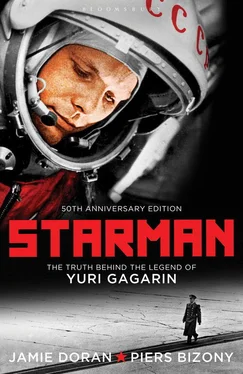Two weeks later, on March 27, Gagarin took off from Chkalovsky (the airbase directly alongside Star City) aboard a two-seater MiG-15UTI jet, with Serugin in the back seat acting as his instructor. The purpose of the flight was to prepare Gagarin for qualifying in a more modern MiG-17, so that he could leave the older plane behind once and for all.
Valentina was in hospital undergoing an appendectomy, and Gagarin planned to visit her later on, at the end of his day’s work.
At 7.30 in the evening, Taissia Serugina started to worry because her husband Vladimir was not yet home. As she remembers, ‘I was waiting for the whole night. I called his air regiment, and every time they said, “He’s not available, but everything’s in order. He’s busy with his work.” No one told me anything. I didn’t sleep, and I left the house next morning for work. Then they notified me that there had been a problem at the airfield, but I didn’t quite believe it. I thought if anything serious had happened to my husband, they would have told me yesterday… Suddenly my daughter ran up to me. “Mother!” she shouted, and there were tears in her eyes. “Father’s dead!” I don’t remember much after that.’
Alexei Leonov was one of only a few cosmonauts to have embraced helicopter flying as a worthwhile discipline. He was involved in the testing of possible lunar landing manoeuvres using adapted helicopters as crude vertical-descent simulators. On the morning of March 27, he was leading a group of cosmonauts through a parachute training run from the Kerzatch airfield, thirteen kilometres from Serugin’s and Gagarin’s base at Chkalovsky. He piloted a large helicopter through the deteriorating weather, trying to find a break in the clouds so that he could release his jumpers.
The cloud base was down to 450 metres and visibility was appalling. Rain and wet snowflakes thudded against the cockpit canopy. Leonov managed to release his first parachute team into the air, but the visibility was closing in fast. The local air-traffic controllers told him that the weather was not going to improve, so he took the helicopter back to Kerzatch with half his parachute team still aboard. ‘Moments after we had landed, we heard two explosions – an explosion and a bang that accompanies a supersonic shockwave. We wondered: what was it? An explosion or a bang? I said it was probably both – that the events were somehow linked. And these two sounds were just over one second apart.’
Chkalovsky was thirteen kilometres away and the sounds were muffled by the damp weather, but even at that distance they were distinguishable. Leonov became increasingly concerned. He knew perfectly well that Gagarin was flying today. On his own authority, he flew the helicopter to Chkalovsky, despite the poor weather. All the way there he monitored the controllers calling Gagarin’s code number, 625, on the radio link. As soon as Leonov touched down at Chkalovsky, a regimental commander came up to him and said, ‘The fuel in Yuri’s plane should have run out forty-five minutes ago, but he’s not returned to the airfield.’
Leonov decided he had better report his unpleasant theory. ‘I went to the Flight Control Office and Nikolai Kamanin was there. I told him, “You might think it’s strange to say this, but I heard an explosion and a supersonic bang.” I gave an estimation of the [compass bearing] I thought the sounds had come from.’
A search helicopter was despatched to overfly the area where Gagarin’s plane had last been spotted on radar, ninety-six kilometres north-east of Moscow. The pilot flew low over the ground and discovered an area of woodland with a bare black patch of scattered earth venting some steam, but visibility was still poor and he could not be sure that this was actually a wreck site. According to Leonov, ‘The search pilot thought the steam might be a natural phenomenon of some kind. He was ordered to land his helicopter and inspect the site on foot. Because of all the trees there was no obvious opportunity to put the helicopter down, so the pilot flew to the nearest open land, near a church, and settled there.’ Apparently he waded for an hour through thick snow, a metre deep in places, to get into the woodlands where he had seen the smoke. When he had found what there was to find, he struggled back to the helicopter and made his report by radio. There was a large crater, he said, and the earth from within it had been thrown outwards across a wide area. Some of the trees at the perimeter were broken, and many small pieces of twisted metal lay all over the site. Clearly this was an aircraft accident, but there was no obvious sign of a central piece of wreckage in the crater: a fuselage, for instance, or a main engine section.
Gagarin and Serugin had lost contact with Chkalovsky traffic control at 10.31 in the morning. By the time the helicopter pilot had waded in and out of the wreck sight, made his report and called for a properly equipped rescue team, it was about 4.30 in the afternoon. The grey winter light, already poor, was fading fast. The search team arrived with powerful torches, but they were of little use in the winter darkness. By evenfall the searchers had identified what appeared to be tatters of Vladimir Serugin’s clothing, and Gagarin’s map case, but they had found no obvious trace of either man’s body, nor of the main sections of the aircraft. ‘Throughout the night two battalions of soldiers searched the forest, but they didn’t find anything,’ Leonov explains. ‘And on the next day, while we were digging deeper into the crater, we found pieces of Gagarin’s flying jacket. It became clear that both of them were still in here somewhere. They didn’t eject.’
The front end of the plane had been rammed with great force several metres into the hard ground, by the sheer momentum of the heavy engine block. The recovery team had to try and dig the cockpit out of the hard-frozen earth. They found that it was utterly smashed, and the two men’s bodies inside were severely mangled. To their great distress, the rescuers spent many hours retrieving fingers, toes, pieces of ribcage and skull from the crater, the surrounding woodlands and even the trees – some of these had to be cut down once they knew what to look for. It became clear that the plane’s impact with the trees had caused terrible damage to the cockpit, even before the final impact on the ground had crushed it once and for all.
Meanwhile Gagarin’s personal driver Fyodor Dyemchuk, who had driven him to Chkalovsky that morning, was quietly waiting for the MiG to return so that he could get his passenger back to central Moscow, to see Valya in the Kuntsevo hospital in the evening. ‘At approximately eleven o’clock [that morning] all of us learned that his radio link was lost. Everyone assumed his transmitter was out of order or something like that.’ But the mood darkened once the search party was ordered later that day. ‘We were told that a crash site had been found and we were under orders to be ready at eight o’clock in the evening. We formed a team, picked up some equipment and went to that place. There was a lot of snow, and the ground was difficult, so it took us most of the night to drive through and reach the crash site. Of course everyone was upset. Everyone felt it. The most horrible thing was the uncertainty.’
At first light next morning, the extent of the crash became clear. Dyemchuk was closely involved in the search to recover every scrap of wreckage, no matter how small or seemingly insignificant. ‘The only large pieces left were the engine, some landing gear, and one wing. The rest was scattered over the entire forest by the force of impact and the explosion. We were walking through the snow. You walk and see a hole in the snow, and you dip your hand in and pull out a piece of flesh or a piece of bone. Sometimes a finger. Those were very dark days.’
Читать дальше












